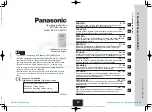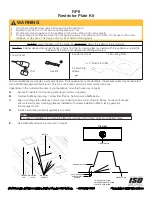
Model S4000CH
11
Sensors should be mounted in an area that is as free from wind, dust, water, shock,
and vibration as possible. See Section 7.3.6 for the environmental specifications of
the unit. If the sensor cannot be located away from dust and rain, then we
recommend the use of our splashguard GM P/N 10395-1 to help protect the sensor.
Sensors may be adversely affected by prolonged exposure to certain materials. Loss of
sensitivity or corrosion may be gradual if such materials are present in low concentrations, or
it may be rapid at high concentrations. The more important materials adversely affecting
sensors are:
Constant presence of high concentrations of hydrogen sulfide (H
2
S) gas
Silicones (often contained in greases and aerosols)
Halides, compounds containing fluorine, chlorine, bromine and iodine
Heavy metals, e.g. tetraethyl lead
Caustic and acidic liquids and vapors
The presence of poisons and contaminants in an area does not necessarily preclude the use
of a Model S4000CH intelligent sensor. The feasibility of using a sensor in such areas must
be determined by an analysis of the specific factors in each application and General Monitors
should be consulted before attempting any such installation.
Sensors used in these areas usually require more frequent calibration checks than normal,
and typically have a shorter life. In many such applications, the standard two-year warranty
would not apply.
WARNING:
General Monitors discourages the painting of sensor assemblies. If the sensor
head is painted over, the gas will not be able to diffuse into the sensor. If the
assembly cover is painted over, the digital display cannot be read.
3.3.1 Remote Mounting of the Sensor from the Electronics
If it is necessary to remotely mount the sensor from the electronics and the housing, the
sensor must be mounted in an explosion-proof rated sensor housing (GM P/N 10252-1 or
10252-3). The 10252-3 sensor housing can be used at temperatures up to 200°C when
used with sensor 11159-2. The cable run must be contained in conduit running from the
sensor housing to the electronics. See Section 7.3.4 for cable lengths. The maximum
cable length to the power supply will be reduced by 10%.
For remote mounting in Canada where the location is classified using the Zone
classification system, the sensors must be mounted in sensor housing B13-020, B13-021,
or B13-022 as applicable. Only sensors 11159 can be used in this configuration.
General Monitors has accessories that help with remote or difficult to get to locations. The
RGC or ARGC facilitate remote gassing.
NOTE:
At an upper ambient of +200°C, the accuracy of the gas readings will be negatively
impacted. For example, in an atmosphere of 10% LEL gas, the sensor will read
approximately 2% LEL; at 25% LEL, the sensor will read approx.15%; at 50% LEL,
the sensor will read approx. 34%; at 75% LEL, the sensor will read approx. 59%, at
85% LEL, the sensor will read approx. 67%.
















































